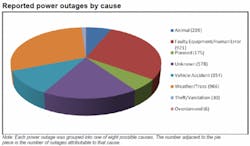Microgrids are the talk of the energy industry, and it’s easy to see why after reading Eaton’s recently released annual Blackout Tracker.
True, the US electric system is an engineering wonder. Some call it the biggest machine in the world. Still, it experienced 3,236 outages last year, 15 percent more than in 2012. This makes a case for microgrids because they can island from the main grid when it’s in trouble. Microgrids keep serving nearby customers with distributed generation.
Why does the US grid blink out so often?
One of the most discussed disruptions last year occurred on April 16, 2013 when attackers shot out transformers at a Silicon Valley substation. The event spurred talk about grid exposure to terrorist attacks. Last month the Wall Street Journal leaked a federal report that said the US could face a massive national outage if just nine key substations were knocked out in a coordinated way.
Looking for more discussion on microgrids? Join our Microgrid Knowledge LinkedIn group.
So far, though, the bad guys have been pretty much kept away. Instead, it is often the little things that bring the grid down, according to the Eaton report. Squirrels, it turns out, are frequent assassins, followed by birds, raccoons, snakes, rodents, cats, and beavers. Parrots roosting on a power lines cut electricity to more than 6,100 customers for three hours last year in Redondo Beach, Calif.
Eaton Blackout Tracker 2013
Then there are humans who do dumb things. About 1,000 people in Washington lost power when a guy got mad at his neighbors and smashed a utility pole with a bulldozer. In Connecticut, a trash collector got out of his truck to take a phone call and his vehicle rolled down the street and smashed a pole. And in San Francisco a plane accidentally dropped an advertising banner that tangled in wires and left more than 2,000 people without power.
But these are the quirky causes of outages. In truth, weather is the biggest headache for the power industry. A blizzard in the northeast left 650,000 without power in February, 500,000 in Michigan lost power before Christmas because of an ice storm, Eaton said. Wind, rain and forest fires took their toll too.
California is the top state for outages (464), a dubious distinction, it has held for three years running, according to the report. Texas followed last year (159); then Michigan (153), Pennsylvania (144), Ohio (136), New York (125), Virginia (117), New Jersey (116), Washington (104), and Massachusetts (98).
Eaton Blackout Tracker 2013
Our electrically driven economy pays a big price when the power goes out. Power outages, surges and spikes cost the US economy an estimated $150 billion in annual damages, Eaton said.
Data centers are particularly sensitive to outages, which cost them an average $7,900 per minute. Eaton cites a Ponemon Institute survey in which 84 percent of data center respondents said they’d rather walk barefoot over hot coals than experience downtime at their facility. Others that pay a big price when the lights go out work in banking, manufacturing, consulting/IT, hospitals, military, control centers (traffic lights, public transit etc., perishable item storage, public safety and entertainment, the report said.
Why Microgrids?
Eaton, of course, has a stake in pointing out grid vulnerabilities. The company offers power protection and microgrid equipment. But it is far from alone in pointing out the US grid has become unwieldy.
The American Institute of Physics recently published an article that asked the question, “Is the Power Grid too Big?” It quotes research that found an optimal grid has 500 to 700 nodes, while the US grid has 16,000 nodes.
“Sandpiles are stable until you get to a certain height. Then you add one more grain and the whole thing starts to avalanche. This is because the pile’s grains are already close to the critical angle where they will start rolling down the pile. All it takes is one grain to trigger a cascade,” said David Newman, a physicist at the University of Alaska, in the article.
Utilities would likely counter that the US grid does a pretty good job, even without microgrids, given its age and pressures. And they are correct. To put the US outages in perspective, consider Haiti, whose national development plan aspires to a mere 12 hours per day of electrical service nationwide by 2032. But who among us in the US can retain such perspective on a hot summer day when the room is too warm and the cell phone is about to run out of charge?
Did you find this article interesting? Read more articles like this by subscribing to Energy Efficiency Markets free newsletter.
About the Author
Elisa Wood
Editor-in-Chief
Elisa Wood is the editor and founder of EnergyChangemakers.com. She is co-founder and former editor of Microgrid Knowledge.
